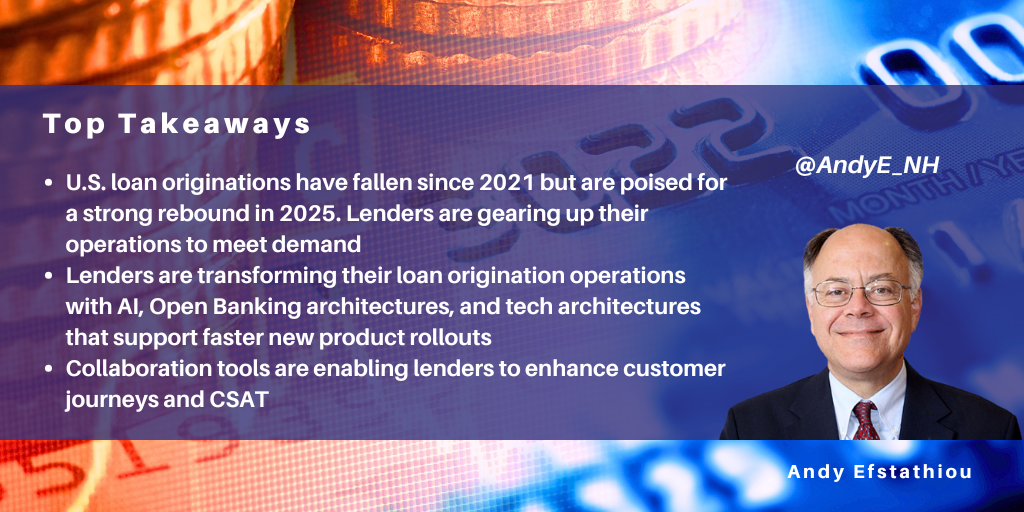Search posts by keywords:
Filter posts by author:
Related Reports
Related NEAT Reports
Other blog posts
posted on Jan 06, 2025 by Andy Efstathiou

Global loan originations have declined since COVID and the trough of interest rates in April 2020. For example, in the U.S., loan originations fell from $4.51 trillion in 2021 to $1.50 trillion in 2023. Currently, interest rates in the U.S. are declining, and mortgage originations in the first three quarters of 2024 have increased by 9% over the prior year. The U.S. lending industry group, the Mortgage Bankers Association, forecasts a 28% increase in mortgage originations in 2025 to $2.3 trillion due to lower interest rates and increased home building providing consumers with a larger inventory at a lower net cost. Lenders are preparing their operations for a strong rebound in lending. This blog looks at some of the initiatives in play.
NelsonHall completed a survey of 60 financial industry executives in August 2024 about their intentions for operational transformation. Mortgage and core banking operations are the areas with the highest need for fundamental change (55% of respondents indicated extensive change is needed). Mortgage operations had the highest level of respondents (60%) saying they would increase their use of standalone operations transformation.
Lenders are looking to transform operations to drive revenue growth and capture the anticipated surge in origination volumes by:
- Using AI to enable hyper-personalization
- Using intelligent agents to enable customers and originators to shop a broader range of offerings and options efficiently
- Adopting flexible tech infrastructure to enable faster loan product introductions
- Implementing open banking architecture to enable partners to offer customers a broader range of financial products and services.
A recent example of the type of operational changes origination lenders are making is Florius, the largest mortgage specialist in the Netherlands, which wanted to simplify the application process for its customers. To meet this goal, it upgraded its systems to:
- Analyze incoming calls and route them to agents with customer-specific knowledge (typically an agent the customer has worked with previously)
- Integrate systems for customer contact, CRM, databases, and fulfillment
- Retain flexibility for future upgrades with APIs and open architecture.
The company did this by upgrading its Avaya Aura solutions for contact center, workforce automation, and collaboration platform (Breeze), which it integrated with its Microsoft Dynamics CRM system. It worked with NTT DATA in consulting, integration, and ongoing managed services to access expertise and upgrades.
Another example is when the largest mortgage lender in the U.S. wanted to redesign its customized, manual mortgage origination systems into a highly automated system that would deliver faster processing, lower error rates (significantly lower rejection rates), and greater scalability to address industry cyclicality. Working with WNS, the lender deployed Mozaiq.ai, an intelligent mortgage automation platform, and KnowRa+, an intelligent agent solution, to support the originators. The result was that the lender could reduce time-to-close, reduce costs, and improve CSAT and new business growth.
This is just a sample of what lenders are doing to prepare for the anticipated growth in lending. I am starting a global market assessment of operations and technology services in the mortgage and loan industry this month. The Transforming Mortgage and Loan Services project will delve deeper into how these initiatives develop, how lenders address the challenges, and how technology services vendors support their clients. The transformation promises to change the underlying lending business model across many geographies, making home and asset ownership accessible to new consumer demographics under more favorable terms than before.
Technology vendors with relevant offerings can contact me directly to participate in this study.
